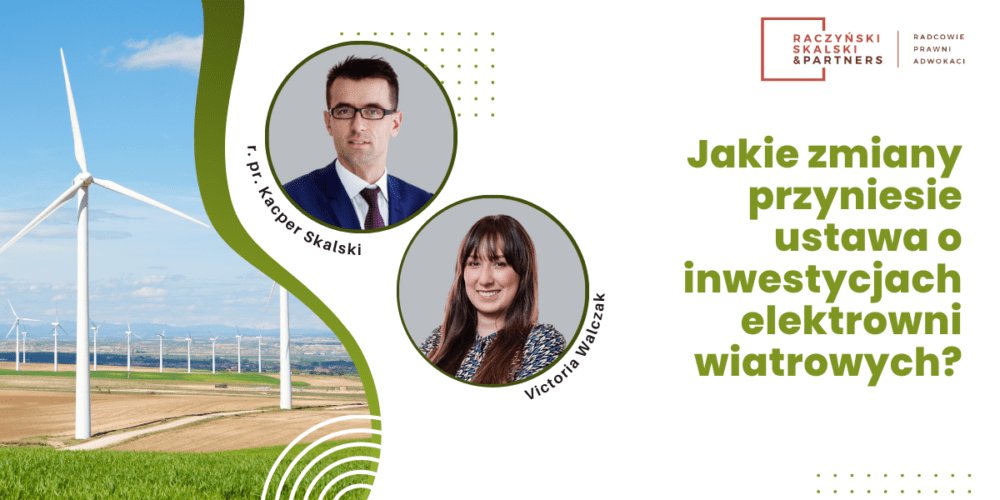On September 25, 2024, a draft law on investments in wind power plants and certain other laws (List Number UD89) was published on the website of the Government Legislation Center. Below is a summary of the most important changes that the Ministry of Climate and Environment proposes:
-
-
-
-
- In the Law of May 20, 2016 on investments in wind power plants:
-
-
-
-
-
-
- introduction of a minimum distance of a wind power plant from buildings, i.e. 500 m;
- introducing a definition of a nearby municipality as a municipality “whose area in whole or in part is located at a distance equal to or less than 500 meters from a wind power plant located on the territory of another municipality.”
- specifying the minimum distance of a wind power plant, i.e. 1,500 meters (for national parks) and 500 meters (for Natura 2000 areas, i.e. special bird and habitat protection areas);
- repealing Article 6a-6f in the Wind Power Investment Law (covering the scope of resolutions to proceed with the preparation of a local plan, as well as to proceed with public consultations), in order to standardize and shorten the process of locating wind power plants;
- introducing changes in the process of gratification of residents, who are also end users. The changes will consist of establishing a minimum installed capacity of 1 MW and transferring 10% of the power from all wind power plants (total capacity of the plants) located in the municipality to residents. The transfer of power will be implemented by the investor offering 10% of the installed capacity of wind power plants usually connected to the electricity distribution grid or directly to the transmission grid. This will enable residents of the municipality to obtain priority in taking up the above-mentioned volume of power and gain the status of virtual prosumer.
- regulating that the transfer of 10% of the power as a gratification to the local community will not adversely affect the realization of electricity sales under the auction system of not less than 85% under Article 79(3)(8) in conjunction with Article 168(15)(a) of the Law on Renewable Energy Sources, due to the fact that the investor at the bidding stage has no influence on how the volume will have to be excluded from the auction system;
- allowing electricity produced and sold at negative prices to be credited for the purposes of accounting for the obligation to sell under the auction system under the Renewable Energy Sources Act;
-
-
2. Regarding amendments to the Law of February 20, 2015 on Renewable Energy Sources:
-
-
-
- amending the definition of a renewable energy source facility by deleting the word “electric” to ensure that storage facilities are recognized not only for electricity, but also for heat and cooling storage;
- clarifying the data on prosumers’ invoices by presenting (i) detailed summaries of the amount and value of electricity injected and withdrawn by month for a given billing period, (ii) including the market price of energy or the market monthly price of energy, and (iii) indicating information on cleared prosumer deposits. This will provide prosumers with full transparency in the settlement of both injected and withdrawn electricity;
- obliging the existing energy seller to return the prosumer deposit overpayment no later than the end of the next month following the month in which the change of seller took place, which will make it possible to regulate the transfer of the prosumer deposit overpayment to the new seller;
- changing the coefficient for retrofitted installations from 100% to 115% at the share of the incurred and documented capital expenditures of the retrofit in the eligible costs of constructing a new reference renewable energy source installation, as defined in Article 74(2d) of the Law on Renewable Energy Sources;
-
-
3. Regarding amendments to the Energy Law of April 10, 1997:
-
-
-
- introducing the possibility of summing the power of a micro-installation and an energy storage facility by regulating that the installed power of a micro-installation, does not include, the installed power of an energy storage facility, as long as the installed power of an energy storage facility is no more than 2.2 times the installed power of a micro-installation;
- amending Article 7a(3)(1) of the Energy Law. By adding the words “with the exception of a direct gas pipeline used to supply biogas,” the drafter introduces the absence of the need to obtain permission from the ERO President, granted by decision, for the construction of a gas pipeline that will be used to supply biogas, prior to the issuance of a construction permit decision within the meaning of the Construction Law;
- introduction of Article 7a2(1) of the Energy Law, which requires the ERO President to maintain and publish in the ERO’s Public Information Bulletin a list of functioning direct gas pipelines for biogas supply, referred to as the “list of direct biogas pipelines”;
- the entity holding the legal title to the pipeline will be required to submit to the ERO President a notification of entry to the aforementioned list of direct biogas pipelines within 30 days from the date of commencement of biogas
-
-
These are just some of the numerous regulatory changes introduced by the draft Law on Wind Power Investments and the Law on Renewable Energy Sources and the Energy Law.
We encourage you to read the draft in detail, which is available at the following link: https://legislacja.rcl.gov.pl/projekt/12389803/katalog/13082924#13082924



